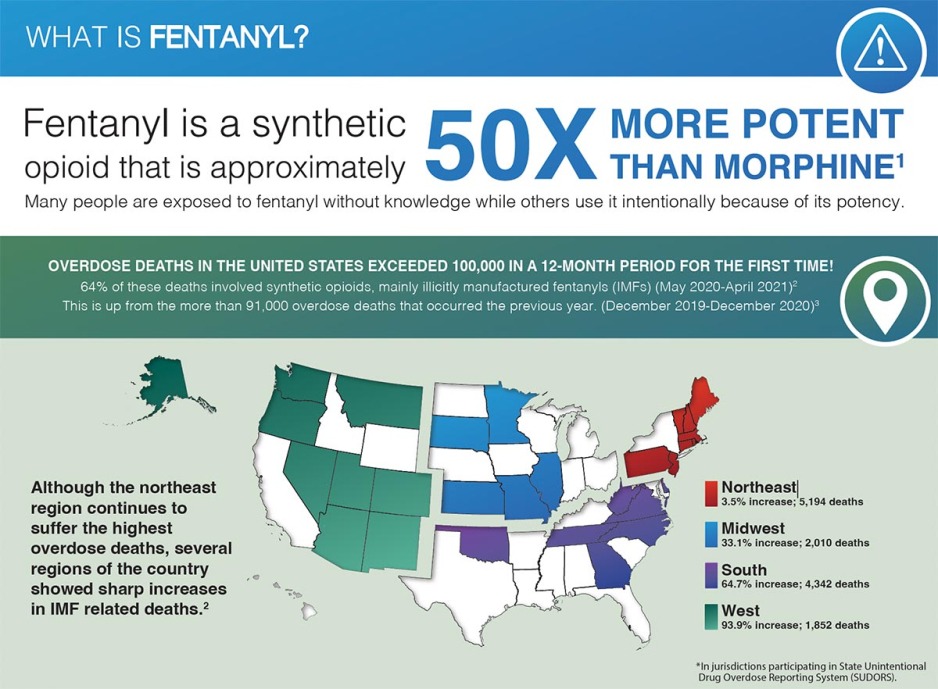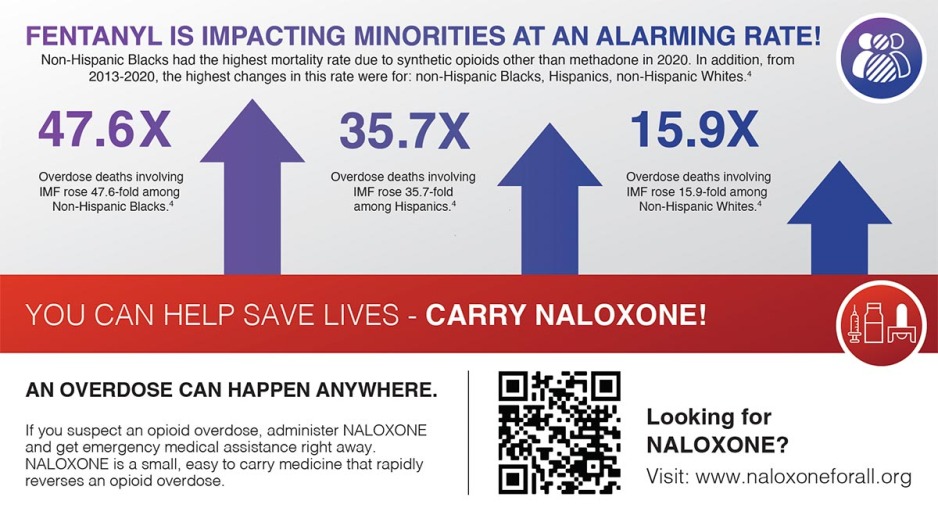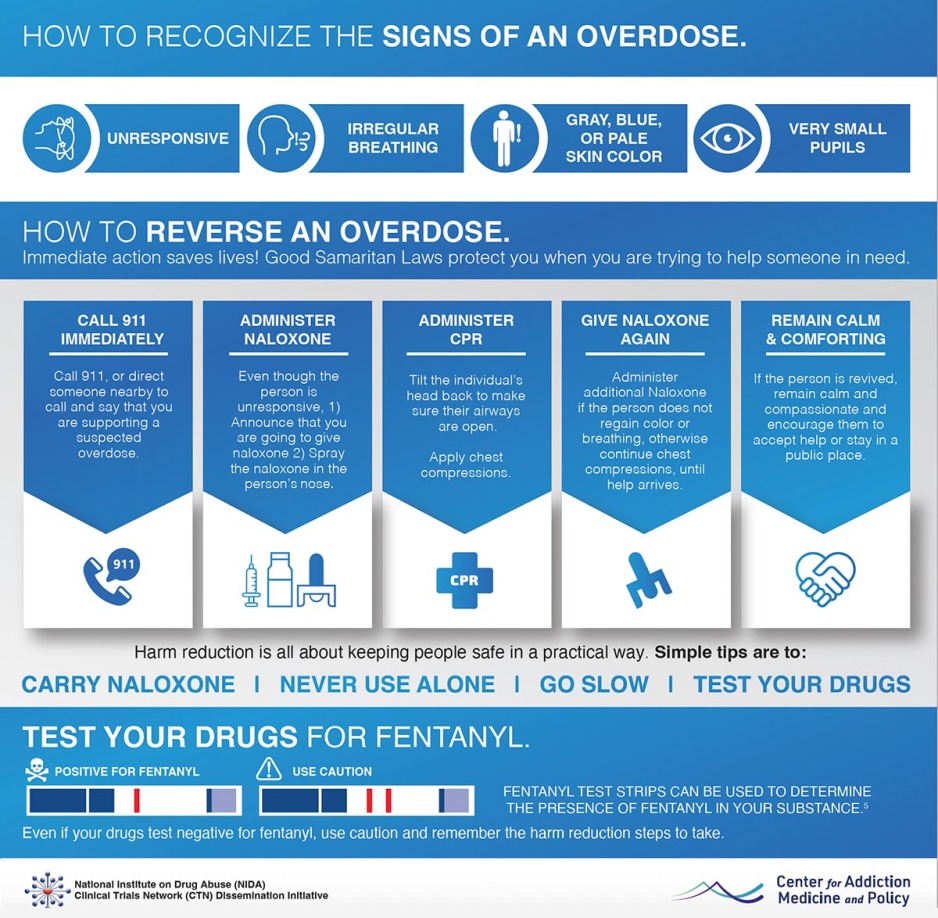Disclaimer: This resource was funded in part with federal funds from the National Institute on Drug Abuse, Center for the Clinical Trials Network Dissemination Initiative (contract # 75N95020C00028RFP). The content was developed by experts and researchers and does not necessarily reflect the official position of the National Institute on Drug Abuse, National Institutes of Health, Department of Health and Human Services; nor does mention of trade names, commercial practices, or organizations imply endorsement by the U.S. government. This information should not be considered a substitute for legal counsel or individualized patient care and treatment decisions.
What is Fentanyl?
- Fentanyl is a synthetic opioid that is approximately 50 times more potent than morphine.
- Many people are exposed to fentanyl without knowledge while others use it intentionally because of its potency.
- Overdose deaths in the United States exceeded 100,000 in a 12-month period for the first time! 64%of these deaths involved synthetic opioids, mainly illicitly manufactured fentanyls (IMFs) (May 2020-April 2021). This is up from the more than 91,000 overdose deaths that occurred the previous year (December 2019-December 2020).
- Synthetic opioids (i.e., illegal fentanyl) appear to be the main driver of the 38.4% increase in overdose deaths from 2019 to 2020.
- Although the northeast region continues to suffer the highest overdose deaths, several regions of the country showed sharp increases in IMF related deaths.
- Northeast – 3/5% increase; 5,194 deaths
- Midwest – 33.1% increase; 2,010 deaths
- South – 64.7% increase; 4, 342 deaths
- West – 93.9% increase; 1, 852 death
- *In jurisdictions participating in State Unintentional Drug Overdose Reporting System (SUDORS)
Fentanyl is impacting minorities at an alarming rate.
- Non-Hispanic Blacks had the highest mortality rate due to synthetic opioids other than methadone in 2020. In addition, from 2013-2020, the highest changes in this rate were for: non-Hispanic Blacks, Hispanics, non-Hispanic Whites.
- Overdose deaths involving IMF rose 47.6-fold among Non-Hispanic Blacks.
- Overdose deaths involving IMF rose 35.7-fold among Hispanics.
- Overdose deaths involving IMF rose 15.9-fold among Non-Hispanic Whites.
- You can help save lives – Carry Naloxone!
- An overdose can happen anywhere. If you suspect an opioid overdose, administer naloxone and get emergency medical assistance right away. Naloxone is a small, easy to carry medicine that rapidly reverse an opioid overdose.
- Looking for Naloxone? Visit: naloxoneforall.org
How to recognize the signs of an overdose
A person will appear to be unresponsive; may have irregular breathing; may appear gray, blue, or have pale skin color; and may have very small pupils.
- How to reverse an overdose – Immediate action saves lives! Good Samaritan Laws protect you when you are trying to help someone in need.
- Call 911 immediately – call 911, or direct someone nearby to call and say that you are supporting a suspected overdose.
- Administer Naloxone – Even though the person is unresponsive: 1) announce that you are going to give naloxone 2) spray the naloxone in the person’s nose.
- Administer CPR – Tilt the individual’s head to make sure their airways are open. Apply chest compressions.
- Give Naloxone again – Administer additional naloxone if the person does not regain color or breathing, otherwise continue chest compressions, until help arrives.
- Remain calm and comforting – If the person is revived, remain calm and compassionate and encourage them to accept help or stay in a public place.
- Harm reduction is all about keeping people safe in a practical way. Simple tips are to:
- Carry Naloxone
- Never Use Alone
- Go Slow
- Test Your Drugs
- Test your drugs for fentanyl
- Fentanyl test strips can be used to determine the presence of fentanyl in your substance
- Even if your drugs test negative for fentanyl, use caution and remember the harm reduction steps to take.
References
- Centers for Disease Control and Prevention. (n.d.). Fentanyl. Retrieved June 16, 2021, from https://www.cdc.gov/opioids/basics/fentanyl.html
- Centers for Disease Control and Prevention. (2020). Overdose Deaths Accelerating During COVID-19. Retrieved August 20, 2021, from https://www.cdc.gov/media/releases/2020/p1218-overdose-deaths-covid-19.html
- Centers for Disease Control and Prevention. (n.d.). Other Drugs. Retrieved June 16, 2021, from https://www.cdc.gov/drugoverdose/deaths/other-drugs.html
- Gladden, R. M., O’Donnell, J., Mattson, C. L., & Seth, P. (2019). Changes in opioid-involved overdose deaths by opioid type and presence of benzodiazepines, cocaine, and methamphetamine—25 states, July–December 2017 to January–June 2018. Morbidity and Mortality Weekly Report, 68(34), 737. DOI: 10.15585/mmwr.mm6834a2
- Nolan, M. L., Shamasunder, S., Colon-Berezin, C., Kunins, H. V., & Paone, D. (2019). Increased presence of fentanyl in cocaine-involved fatal overdoses: implications for prevention. Journal of Urban Health, 96(1), 49-54. DOI: 10.1007/s11524-018-00343-z
- Wang, Y., Goldberger, B. A., & Delcher, C. (2020). Florida Drug-Related Outcomes and Surveillance Tracking System (FROST). University of Florida.
- Agency for Healthcare Research and Quality. (n.d.). Blacks Experiencing Fast-Rising Rates of Overdose Deaths Involving Synthetic Opioids Other than Methadone. Retrieved June 16, 2021 from https://www.ahrq.gov/sites/default/files/wysiwyg/research/findings/nhqrdr/dataspotlight-opioid.pdf
- Lippold, K. M., Jones, C. M., Olsen, E. O. M., & Giroir, B. P. (2019). Racial/ethnic and age group differences in opioid and synthetic opioid–involved overdose deaths among adults aged ≥ 18 years in metropolitan areas—United States, 2015–2017. Morbidity and Mortality Weekly Report, 68(43), 967. DOI: 10.15585/mmwr.mm6843a3
- Centers for Disease Control and Prevention. (2021). Federal grantees may now use funds to purchase fentanyl test strips. Retrieved September 14, 2021, from https://www.cdc.gov/media/releases/2021/p0407-Fentanyl-Test-Strips.html
- CDC Health Advisory - emergency.cdc.gov/han/2020/han00438.asp


